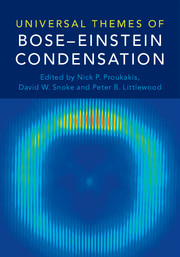Book contents
- Frontmatter
- Contents
- Foreword
- Preface
- Part I Introduction
- Part II General Topics
- Editorial Notes
- 5 The Question of Spontaneous Symmetry Breaking in Condensates
- 6 Effects of Interactions on Bose-Einstein Condensation
- 7 Formation of Bose-Einstein Condensates
- 8 Quenches, Relaxation, and Prethermalization in an Isolated Quantum System
- 9 Ultracold Gases with Intrinsic Scale Invariance
- 10 Berezinskii-Kosterlitz-Thouless Phase of a Driven-Dissipative Condensate
- 11 Superfluidity and Phase Correlations of Driven Dissipative Condensates
- 12 BEC to BCS Crossover from Superconductors to Polaritons
- Part III Condensates in Atomic Physics
- Part IV Condensates in Condensed Matter Physics
- Part V Condensates in Astrophysics and Cosmology
- Universal Bose-Einstein Condensation Workshop
- Contributors
- Index
- References
11 - Superfluidity and Phase Correlations of Driven Dissipative Condensates
from Part II - General Topics
Published online by Cambridge University Press: 18 May 2017
- Frontmatter
- Contents
- Foreword
- Preface
- Part I Introduction
- Part II General Topics
- Editorial Notes
- 5 The Question of Spontaneous Symmetry Breaking in Condensates
- 6 Effects of Interactions on Bose-Einstein Condensation
- 7 Formation of Bose-Einstein Condensates
- 8 Quenches, Relaxation, and Prethermalization in an Isolated Quantum System
- 9 Ultracold Gases with Intrinsic Scale Invariance
- 10 Berezinskii-Kosterlitz-Thouless Phase of a Driven-Dissipative Condensate
- 11 Superfluidity and Phase Correlations of Driven Dissipative Condensates
- 12 BEC to BCS Crossover from Superconductors to Polaritons
- Part III Condensates in Atomic Physics
- Part IV Condensates in Condensed Matter Physics
- Part V Condensates in Astrophysics and Cosmology
- Universal Bose-Einstein Condensation Workshop
- Contributors
- Index
- References
Summary
We review recent results on the coherence and superfluidity of driven dissipative condensates, i.e., systems of weakly interacting nonconserved bosons, such as polariton condensates. The presence of driving and dissipation has dramatically different effects depending on dimensionality and anisotropy. In three dimensions, equilibrium behaviour is recovered at large scales for static correlations, while the dynamical behaviour is altered by the microscopic driving. In two dimensions, for an isotropic system, drive and dissipation destroy the algebraic order that would otherwise exist; however, a sufficiently anisotropic system can still show algebraic phase correlations. We discuss the consequences of this behaviour for recent experiments measuring phase coherence and outline potential measurements that might directly probe superfluidity.
Introduction
This chapter is dedicated to superfluidity and its relation to Bose-Einstein condensation (BEC), a topic with a long history. Many reviews of the concepts of condensation and superfluidity in thermal equilibrium can be found; see for example Refs. [1, 2, 3, 4]. The focus of this chapter is on how these concepts apply (or fail to apply) to driven dissipative condensates – systems of bosons with a finite lifetime, in which loss is balanced by continuous pumping. We focus entirely on the steady state of such systems, neglecting transient, time-dependent behaviour.
Experimentally, the most studied example of a driven dissipative condensate has been microcavity polaritons, an overview of which is given in Ref. [5] and Chapter 4. However, similar issues can arise in many other systems, most obviously photon condensates [6] (see also Chapter 19), magnon condensates [7] (see also Chapters 25–26), and potentially exciton condensates (although typical exciton lifetimes are much longer than for polaritons). Even experiments on cold atoms (see, e.g., Chapter 3) could be driven into a regime in which such physics occurs, when considering continuous loading of atoms balancing threebody losses [8] or atom laser setups [9, 10, 11].
Experiments on polaritons are two-dimensional, and in two dimensions it is particularly important to clearly distinguish three concepts often erroneously treated as equivalent: superfluidity, condensation, and phase coherence. This is because no true Bose-Einstein condensate exists in a homogeneous two-dimensional system.
Information
- Type
- Chapter
- Information
- Universal Themes of Bose-Einstein Condensation , pp. 205 - 230Publisher: Cambridge University PressPrint publication year: 2017
References
Accessibility standard: Unknown
- 3
- Cited by
